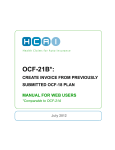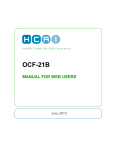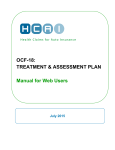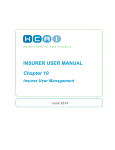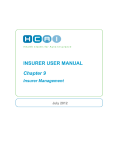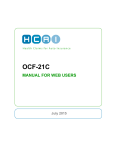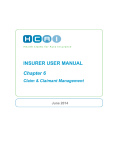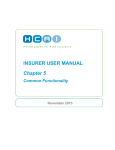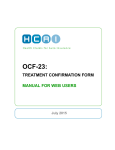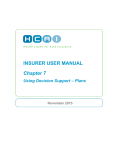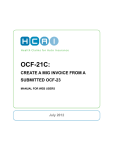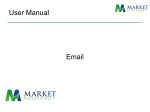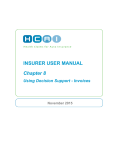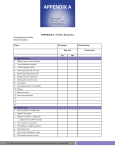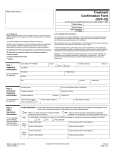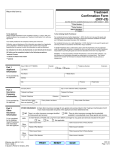Download OCF-21B: Creating invoice from scratch
Transcript
OCF-21B: CREATE INVOICE FROM SCRATCH MANUAL FOR WEB USERS July 2012 Table of Contents WHEN DO I USE AN OCF 21B ...................................................................................... 4 WHAT IS INCLUDED IN THIS MANUAL? ..................................................................... 4 WHERE CAN I GET MORE INFORMATION?.............................................................................................. 4 EXAMPLES OF COMPLETED SECTIONS OF THE FORMS ........................................................................... 4 OCF-21B: CREATE INVOICE FROM SCRATCH .......................................................... 5 INTRODUCTION ................................................................................................................................... 5 WHO COMPLETES THIS FORM TO PREPARE IT FOR SUBMISSION TO THE INSURER? .................................. 5 WHAT IS THE INSURER’S ROLE?........................................................................................................... 5 FEE ................................................................................................................................................... 5 COMPLETION OF AN OCF-21B IN HCAI...................................................................... 6 OCF-21B TABS................................................................................................................................ 6 TAB 1.............................................................................................................................. 7 PART 1 – APPLICANT INFORMATION ..................................................................................................... 8 PART 2 – AUTO INSURER INFORMATION ............................................................................................... 8 TAB 2.............................................................................................................................. 9 PART 3 – INVOICE DETAILS ................................................................................................................. 9 PART 4 – PAYEE INFORMATION ......................................................................................................... 10 TAB 3............................................................................................................................ 11 INJURY AND SEQUELAE CODES ......................................................................................................... 11 REIMBURSABLE GOODS AND SERVICES .............................................................................................. 13 PRIOR BALANCE, OVERDUE AMOUNTS AND INTEREST CHARGES ........................................................ 16 TAB 4............................................................................................................................ 17 OTHER INSURER INFORMATION ......................................................................................................... 17 CHARGED SERVICES (SERVICES CHARGED TO OTHER SOURCES)......................................................... 17 TOTALLING ....................................................................................................................................... 18 ADDITIONAL INFORMATION ................................................................................................................ 18 -2- TAB 5............................................................................................................................ 19 ADDITIONAL COMMENTS ................................................................................................................... 19 HOW DO I KNOW MY FORM HAS BEEN SUBMITTED? ........................................... 19 WHAT IF MY FORM HAS NOT BEEN SUCCESSFULLY SUBMITTED?.................... 20 -3- When Do I Use an OCF 21B An OCF-21B is used when invoicing for goods and services delivered to Claimants with the exception of services delivered in the Minor Injury Guideline (MIG) for accidents on or after Sept 1, 2010, or the PreApproved Framework (PAF) for accidents prior to Sept 1, 2010. For MIG or PAF invoicing, use the OCF21C. For all other invoicing, use the OCF -21B. What Is Included in This Manual? This manual provides detailed instructions for completion of an OCF-21B using the HCAI Web application. Where can I get more information? This manual is updated from time to time. The latest updates to the manual can be downloaded from www.hcaiinfo.ca. Contact your Health Professional Association with any questions relating to coding of injuries, interventions, health care services and guidelines as they relate to your specific practice. Examples of completed sections of the forms The examples and fees used throughout the manual are entirely fictitious. They are designed to assist you in understanding how to use and complete the forms. -4- OCF-21B: CREATE INVOICE FROM SCRATCH Introduction In HCAI, your health care Facility (HCF) has two options for OCF-21B creation: 1. Create an Invoice from scratch. This option is used when your Facility has not previously submitted an OCF-18 via HCAI. o Example i: Services are delivered by a different HCF than the one that submitted the OCF-18. 2. Create an Invoice from a Plan (refer to OCF User Manual for “OCF-21B: Create Invoice from Previously Submitted Plan OCF-18”. This option can be used only once an OCF-18 has been submitted via HCAI. Who completes this form to prepare it for submission to the Insurer? OCF-21s that are being prepared on the HCAI Web application must be completed by the HCF that is seeking payment by the Insurer. Applicant signature is not required. What is the Insurer’s role? After your HCF completes and submits the OCF-21, it will appear in the Invoices > Work in Progress sub-tab. The Invoice will be in the “Submitted” state, until an Insurer user views the form. If the Facility has submitted a form in error, the form can be withdrawn up until an Insurer user views the form. Once the Insurer matches the form to the Claimant, the Insurer will be able to adjudicate the form. At that point, the form will continue to appear in the Invoices > Work in Progress worklist; however, it will appear in the “In Review” state. After the form is adjudicated, the adjudicated form will move to the Invoices > Adjuster Response tab, where it can be viewed online and/or printed. Fee There is no fee payable for completion of the standard Invoice. -5- Completion of an OCF-21B in HCAI Figure 1: Invoices global tab Go to the Invoices tab and any sub-tab (see Figure 1). Select OCF-21B from the dropdown list and click OCF-21B TABS The OCF-21B in HCAI is organized under five tabs. Figure 2: OCF 21-B tabs Tab 1 Claim Identifier Invoice Identifier Part 1 – Applicant (Patient) Information Part 2 – Auto Insurer Information Tab 2 Part 3 – Invoice details Part 4 – Payee Information (pre-populated) Tab 3 Injury and Sequelae Codes Reimbursable Goods and Services Totalling Tab 4 Other Insurer Information Totalling Tab 5 Additional Comments and/or Attachments -6- . A blank OCF-21B will open. TAB 1 Claim Identifier Persons who report injuries sustained in an automobile collision will be contacted by the Insurer to which they make the Claim for benefits. The Insurer is required to provide the injured person (Claimant) with a Claim number, date of loss etc. The insurance Policy number can be obtained from the pink slip that is provided when the auto insurance Policy is issued. Claim identifiers are used to identify the Claimant and match the document to a specific Adjuster’s worklist. When a form arrives at the insurance company, the Insurer must match information contained in this section of the form. Note: Errors may delay the Insurer’s ability to identify a Claimant and, subsequently, process the Claim. Four key identifiers Four key identifiers will assist Insurers to quickly validate and adjudicate the Claim: 1. Claim number and/or Policy number The Applicant must provide the Claim number (if known), the Policy number and the date of the accident. o The Claim number and Policy number can be obtained from the insurance Adjuster. o The Policy number is also available on the Motor Vehicle Liability Insurance Card (pink slip). o The Claim number and Policy number may be the same. 2. The accident date (forms will not be processed without an accident date) If the patient has overlapping injuries from more than one accident, use the date of the accident that is most relevant to the injuries being treated. 3. Date of birth of the Applicant. 4. Gender of the Applicant. -7- Invoice Identifier This information cannot be entered in Tab 1. Part 1 – Applicant Information The Applicant (patient) or substitute decision-maker 1 should provide this information to the Facility. Figure 3: Applicant Information Part 2 – Auto Insurer Information The Applicant (patient) or substitute decision-maker should provide the information. The last name of the Policy Holder is mandatory. Independent adjusting companies and Adjusters Independent adjusting companies may be hired by Insurers to adjudicate Claims, but the HCAI application does not list independent adjusting companies. To direct Claim forms appropriately, the Facility should determine (typically by asking the patient or the independent Adjuster) the name of the licensed Insurer that insures the patient. Insurers that use independent Adjusters (IAs) are able to give IAs access to HCAI so they can view and adjudicate the Claimant OCFs for which they have been authorized. Policy Holder Details If the injured person seeking treatment is the Policy Holder, select “Yes” to the question “Is the Policy Holder the same as the Applicant?” If the injured person is not the Policy Holder, select “No” and enter the last name of the Policy Holder. The name of the Policy Holder can be obtained from the pink slip of the proof of insurance form. 1 The Substitute Decisions Act states that a substitute decision-maker is a person with power of attorney for personal care or a court-appointed guardian. -8- TAB 2 Part 3 – Invoice Details Figure 4: Invoice Details If your Facility uses an internal Invoice numbering system, you may enter it in the “Provider Invoice Number” Field. o This number will appear in the HCAI worklist and will help you locate an Invoice after you have submitted it. o It is not a mandatory field and may be left blank. Click “Yes” for “First Invoice” if your Facility has not previously invoiced the Insurer for the associated Plan. Click “Yes” for “Last Invoice” if this is the last Invoice to be submitted for the associated Plan. Previously Approved Goods and Services Click “Yes” if the goods and services being invoiced are approved in the associated Plan and enter the Plan’s Document Number. o If you do not have the Document Number, select “Yes” and type “exempt” into the Document Number field. FSCO’s HCAI Guideline explains when it is appropriate to request an exemption. If your Invoice includes goods and services that are not included in an approved Plan, select “No”. This indicates you have selected an exemption from providing a Document Number. -9- Part 4 – Payee Information When the HCF was registered with HCAI, the clinic will have chosen “Yes” or “No” in response to the question “Lock Payables?” o If the HCF selected “Yes,” the field next to “Make Cheque Payable to” will be pre-populated. o If the HCF selected “No,” the field next to “Make Cheque Payable to” may be changed. Figure 5: Payee Information - 10 - TAB 3 Injury and Sequelae Codes Invoices created to bill for services proposed on an OCF-18 Enter the appropriate injury and sequelae codes for the problems for which treatment is being invoiced. Invoicing for assessment services If invoicing for assessment services, enter the injury/problem code(s) most appropriate for the Claimant based on the assessment findings. If invoicing prior to the assessment’s completion and no impairment has yet been identified, code the problem that instigated the assessment. o Example: An OCF-18 assessment proposal was generated because there was a question about the degree of Health Care Provider dependency. The ICD-10-CA code would be Z74 (problems related to Health Care Provider dependency). o Example: An OCF-18 assessment proposal was generated due to an ongoing pain in the absence of abnormal physical findings. The ICD-10-CA code might be R52.9 (pain unspecified). To learn how to search for injury codes, refer to the HCAI Web User Manual, which can be accessed . on any HCAI web page by clicking Questions about coding Refer any questions regarding injury coding to your Health Professional Association or access the website at www.hcaiinfo.ca. ICD-10-CA codes may reflect a diagnosis, condition, problem or circumstance that is responsible for the services being proposed. o ICD-10-CA codes are not profession specific. o The use of ICD-10-CA codes is intended to convey problems and is not necessarily the equivalent of communicating a diagnosis. List the injuries and sequelae that are a direct result of the automobile accident. Descriptions will be provided with the corresponding injury code (ICD-10-CA). Each code should be listed only once, regardless of how many health care providers will be engaged in the treatment. The first line item should list the problem that is most responsible for the services on the Plan. In other words, it should reflect the primary reason you are proposing services, with the most significant injury first (i.e., the patient’s most significant condition that is directly related to the automobile accident and that requires health care services). o Example If psychological services are required after a brain injury, the first code listed should reflect the reason that psychology services are being proposed. F07.2 – Postconcussional Syndrome S06 – Concussion In a case where multiple injuries may be classified as the most significant, list the injury requiring the most services first. - 11 - If an injury has resolved (e.g., a healed fracture) or is not the condition most responsible for the services in the Plan, list that problem/injury last; alternatively, that problem can be relegated to Part 8 “Prior and Concurrent Conditions” (i.e., a resolved problem can be considered a prior problem). o Example Original injury is S73 – Fractured femur. The surgeon reports that the fracture is healed. The femoral fracture is resolved, but ongoing treatment is required to manage pain and gait re-education. In this case, the problems listed could be: M79.6 – Pain in limb; and R26 – Abnormalities of gait. Should more space be required for additional injury or problem codes, you may add extra lines. Common codes Single physical injury – refer to S codes. Multiple injuries and bilateral injuries – refer to T codes (do not list duplicate codes for bilateral injuries). Mental and behavioural disorders – refer to F codes. Symptoms, signs and abnormal clinical and lab findings, not elsewhere classified – refer to R codes. Adding additional lines for injury/sequelae codes To add lines for additional injuries, simply click on the sign near the bottom of the box. Figure 6: Add additional injury/problem code line Refer to Appendix A, which is the partial pick list of injury/problem codes available at www.hcaiinfo.ca or contact your health professional association. - 12 - Reimbursable goods and services Figure 7: Reimbursable Goods and Services line Date service rendered All dates on which the Claimant attended for treatment should be listed. Dates should be formatted yyyy/mm/dd, and may be cut and pasted if several line items were delivered on the same date. The calendar utility may also be used (Figure 8). Figure 8: Date Services Rendered Code Enter the intervention by typing it directly into the field under “Code.” Or use the code search utility by clicking the blue button next to the “Code” field (see Figure 9). Figure 9: Intervention code . Select either “CCI” (Canadian Classification of Interventions) or GAP. o CCI are international standard codes for health interventions. However, some services were not well represented in the CCI; therefore, GAP codes were developed specifically for Ontario’s auto insurance sector. o GAP codes can be used for services that are not well reflected in the CCI. Assessments including: Administrative services such as travel time and mileage Pre-Claim examination Goods and Supplies Health Provider Initiated Examination & Insurer Initiated Examination including: o Attendant care o Catastrophic o Disability (Pre 104 weeks and Post 104 weeks) o Combined (MedRehab and Disability) o MedRehab Session Codes Telephone consultation with other Health Care Providers - 13 - Attribute In addition to the CCI code, health care services can be further specified with “Attribute Codes”. These codes are used to indicate how the service was delivered or, for example, the number of views in an X-ray study. Provider reference Use the dropdown list to select the Health Care Provider who delivered care on a given date. If more than one Health Care Provider delivered care, list only the one who was most responsible for each visit that is listed on the Invoice. Insert one Health Care Provider for multiple line items There is a shortcut for inserting one Health Care Provider name in multiple line items, as follows: 1. Complete all fields except for the “Provider Ref” fields. 2. Tick each box to the left of the each completed line item). 3. Click . Select the name of the Health Care Provider from the dropdown list and that name will populate all lines under “Provider Ref.” Figure 10: Select line items for one Health Care Provider Cost HCAI enables HCFs to enter a default hourly rate for each Health Care Provider, which will be used in calculating the cost per line of treatment. Report the cost per service as described in the line. o Example: If the service was delivered for 0.5 HR, the cost column should reflect the cost to deliver that service by the Health Care Provider listed for 0.5 HR. o o Note: Do not insert the hourly rate in this column. Example: 15 minutes of massage. 0.25 HR by a massage therapist = 25% of the RMT’s hourly fee. 0.25 x $53.66 = $13.41. This amount should be entered in the field under the “Cost” column. o While HCFs may charge fees in excess of the Superintendent’s Professional Fee Guideline, Insurers are not required to pay fees that exceed that Guideline. - 14 - Calculate Costs From Rates This functionality is explained in Chapter 5 of the User Manual. Calculating Tax If Tax is applicable to a line item, check the box in the “Proposed Tax” column. Tick the box to the right of any line item to which you want to add tax Calculate When all of the proposed goods and/or services have been entered and any required fields in the Totalling section have been completed, click . HCAI calculates Tax (HST) and enters the amount into the Auto Insurer Total. If you wish to manually enter a different tax amount for your invoiced goods/services: I. Click and uncheck the II. Enter the new amount in the “Tax (if applicable)” field III. Click button underneath the Totalling box for the new “Auto Insurer Total” Figure 11: Totalling and Tax Amounts - 15 - Prior Balance, Overdue Amounts and Interest Charges o If the Facility has submitted an Invoice prior to the current Invoice, but it has not been fully paid, you may document the outstanding amount and associated interest on this Invoice. o Insert the Prior Balance – which is the amount of the previous Invoice. o Insert the amount of payment already received on the previous Invoice. o Insert the overdue amount from the previous Invoice. o Insert the tax as calculated on the overdue amount. Note: The overdue amount will not be added to the Auto Insurer Total on this new Invoice. Only the interest amount will be added to this Invoice. The previous Invoice is still effective and amounts from prior Invoices should not be added to new Invoices. - 16 - TAB 4 Other Insurer Information Figure 12: Other Insurer Information Select “Yes” or “No” to establish whether there is other insurance coverage. If yes: o Enter the information underneath Other Insurer 1 and, if applicable, Other Insurer 2. o These fields are NOT mandatory if you do not have the information. Charged services (services charged to other sources) Note: Amounts for services that have been paid or are estimated to be payable by other insurance sources must be entered with a negative sign preceding the dollar amount. 1. Categorize amounts by chiropractic, physiotherapy, massage therapy and other. When the category “Other” is used, specify the type of services covered (e.g., dental, psychological, optometric). 2. Amounts may be signed (+/-) or unsigned. a. If amounts are payable by another Insurer, collateral source or the Applicant, use a negative (-) sign. These amounts will be deducted from the amount owed by the auto Insurer. b. For amounts previously identified for payment by another Insurer but subsequently ruled ineligible, use a plus (+) sign or leave unsigned. These amounts will be added to the subtotal automatically. - 17 - Totalling There are 9 lines in this section: It is possible to bill for amounts greater or less than those proposed on a Plan, but the Insurer may request an explanation. Lines 1, 2 and 3 are populated by HCAI using the information entered in the previous tab. o Sub-total – sum of the cost of all goods and services included on all pages of this Invoice. o Minus MOH – sum of all Ministry of Health and Long-Term Care amounts. This amount is taken from the “Charged Services” MOH line. – o Minus Other Insurer (1 + 2) – sum of all amounts received or payable to you from other Insurers. This amount is taken from the “Charged Services” lines 2 and 3. – Amounts paid to you or expected to be paid to you are subtracted from the amount billed to the auto Insurer. Amounts that you previously stated were available for you to receive but that you were unable to collect are added to the auto Insurer’s Invoice. Amounts paid to you or expected to be paid to you are subtracted from the amount billed to the auto Insurer. Amounts that you previously stated were available for you to receive but that you were unable to collect are added to the auto Insurer’s Invoice. Line 4, Tax. o Tax is calculated at a default rate of 13% to reflect HST. If you wish to charge a rate other than 13%, you may edit this field. Lines 5, 6, 7 and 8 are used as the basis for interest charges that have accumulated. This amount is not calculated into the Auto Insurer Total amount. o While the interest amount is added to the total, the amount owing from prior Invoices is not added to the total. Enter Prior Balance (the “Auto Insurer Total” from your last Invoice). Subtract Payments Received since your last Invoice to calculate Overdue Amount. Enter the interest owing as a result of the Overdue Amount. Line 9 is the Auto Insurer Total – the sum of all amounts in this section. Additional information In Tab 4, near the bottom of the HCAI page, there is space that permits comments when there is a need to provide additional explanations/clarifications to the Insurer. Only 500 characters are allowed here. If more space is needed, use Tab 5. Figure 13: Additional Information - 18 - TAB 5 Additional Comments Figure 14: Additional Comments and attachments How do I complete Additional Comments? HCAI enables HCFs to: Provide more information to Adjusters by using the space given in Tab 5. Advise Adjusters that additional documentation (attachments) the Insurer requires to adjudicate the form is being sent. How should attachments be sent? Attachments must be faxed/mailed directly to the Adjuster. Attachments cannot be sent electronically via HCAI and should not be sent to HCAI. To indicate that an attachment is being sent to the Adjuster, check off “Attachments being sent, if any.” When this box is checked, use the space below to describe the attachment being sent. HCAI enables HCFs to do the following: o Offer more information to Adjusters by using the space provided in Tab 5. o Advise Adjusters that additional documentation (attachments) is being sent that the Insurer will need to adjudicate the form. Attachments cannot be sent electronically via HCAI and must be faxed/mailed to the Adjuster. To indicate an attachment is being sent to the Adjuster, tick the box beside “Attachments being sent, if any.” (Figure 14). If this box is ticked, the health Facility must use the space below to describe the attachment being sent. How do I know my form has been submitted? When your form is complete, you may save it and a version will remain in the Invoices > Draft sub-tab for future use for this or another Applicant. When you are ready to submit the form, click on the - 19 - button at the top or bottom of tabs 4 or 5. Figure 15: Successful submission confirmation notice Figure 15 is an example of what you will see if your form has been successfully submitted to the insurer. Each OCF is assigned a unique Document Number by HCAI that can be used to track the form and distinguish it from others submitted for the same Applicant. What if my form has not been successfully submitted? Look for the error message in orange. HCAI validates data entered in the application as you move through the first four tabs. Errors will be flagged by an orange tab (see Figure 16) or through error messages in yellow (see Figure 16). Figure 16: Error notice (orange tab) When you select a tab with an error, an exclamation mark will appear next to the field with the error and a description of the error at the top of the section (see Figure 17). Figure 17: Explanation of error - 20 -




















